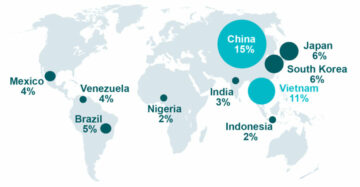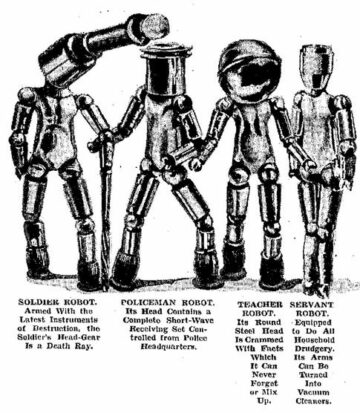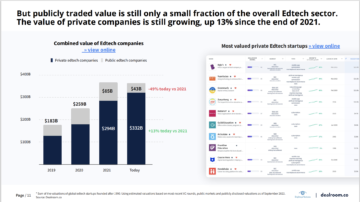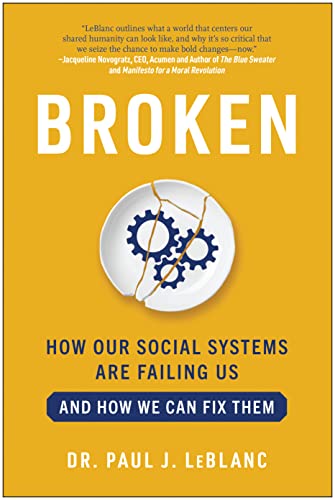
As I outlined recently in my “e-Literate’s Changing Themes for Changing Times” post, I am shifting my coverage somewhat. I’ll be developing and calling out tags I use for these themes so that you can go to an archive page on each one. This one will be listed under the “changing enrollment”, “future of academic work” and “third-wave EdTech” tags.
I recently ran across a white paper called Ideas for an Affordable New Educational Institution out of MIT’s J-WEL center. While the paper contains no groundbreaking new ideas, the gestalt of it is interesting and timely. My first thought after reading it was, “If I were designing the Cal State system in 2022, starting with a blank sheet of paper, this paper would be one decent blueprint to start from.” That kind of practical synthesis is valuable and, sadly, under-rewarded.
And as it turns out, I know and respect one of the authors. My call with him confirmed my sense that this paper is worth writing about.
The context of the paper
It’s often hard to know where these sorts of papers are coming from—and what they might lead to—without additional context. J-WEL is one of many funded centers at MIT. To what extent is the university’s leadership aware of the paper? What are the odds that MIT might act on the recommendations? What are the motivations of the authors? What do they think or hope to accomplish?
Through a quirk of fate, I am fortunate to know one of the five professors from different disciplines who are listed as the paper’s authors. S. P. Kothari was a Professor of Accounting at the University of Rochester during my brief stint as an English graduate student there. I helped him with a couple of writing projects as a way to earn a little extra cash. He was unfailingly kind and always expressed gratitude that seemed out of proportion with the modest help I offered. Beyond that, two things stuck with me about S. P. First, he was interested in designing software to teach students accounting. This was back in the 1990s, so it was early for a professor outside of an education or computer science department to be thinking about such things. Second, while I knew nothing about his field, the clarity of thought in his academic writing and the celebrated status of some of his co-authors suggested to me that he was an up-and-comer.
I was certainly right about his career prospects. He went on to chair MIT Sloan School’s Department of Economics, Finance and Accounting; then became Deputy Dean of the school; and eventually serve for three years as the Chief Economist for the Security and Exchange Commission of the United States before returning to MIT. Despite being at the top of his field,
S. P. clearly never lost his passion as an educator. I gather the same is true for his co-authors. The group started its work with some funding from J-WEL and continued on a volunteer basis afterward because they all cared about the project. I did not get the impression from S. P. that MIT will be picking up this work. But the authors are still trying to bring attention to their proposal in the hopes that somebody will take it forward.
That, then, provides the lens through which the paper should be examined. It is a passion project by highly accomplished scholars in diverse disciplines, none of which is education, and supported by some limited funding. Accordingly, I read it with the same spirit of generosity in which it has been offered. At the same time, it’s worth acknowledging that the document contains some tensions and elisions that are typical of such endeavors. The authors make clear that this paper isn’t a fully formed, shovel-ready proposal. Rather, it is a thought piece and discussion starter.
The context of the need
The authors state their rationale and goals up front:
The conventional model of higher education is facing growing skepticism. With rising tuition costs, ballooning debt, and concerns about preparedness for the work force, many are doubting the value of higher education. Alternative credentials and online offerings are gaining currency.
Viable solutions to these challenges will require abandoning some of our long-held assumptions about how institutions of higher education should operate. But our core educational values—that each learner deserves individual attention and encouragement, and that education should nourish the entire person and not simply provide short-term skills—must be preserved. So we reject solutions that involve replacing teachers by robots, taking all lessons online, or demoting the humanities.
We describe an alternate model for baccalaureate education that offers key levers for addressing these challenges. We list the features of this hypothetical “New Educational Institution,” or NEI, below. NEI is intended to be a new class of institution that is different from traditional R1 or R2 research universities. The focus of NEI will be on majors such as computer science and business, and eventually, broader areas of engineering and design.
This proposal might be called radically conservative in the sense that it is intended to conserve the best parts of an American-style liberal arts education by re-imagining it but not rejecting it. It will take on the challenges of cost and career value without rejecting the value of liberal arts of human teachers.
The authors confine the scope of their NEI to “eventually, broader areas of engineering and design.” In this respect, I think they may be too modest in their ambition. To understand the potential role this model could play, we need to review a little history.
The 1960 California Master Plan—the template from which the modern US higher education system has been built—had a variety of limitations and trade-offs, but one of the most glaring from the very beginning was the lack of identity for the middle tier. California created three systems for higher education. On the bottom was the California Community College System. Any student anywhere in the state would be within easy commute of a college that could offer a two-year degree, an on-ramp to skilled work, and the ability to transfer credit to four-year institutions. Community colleges accept the top 100% of students who apply.
The top tier, the University of California System, would comprise universities that offered advanced degrees and conduct significant research. These institutions would be selective and model themselves after prestigious private universities in their range of activities and emphasis on scholarship.
In the middle was the California State University System. More selective than the community colleges but less selective than the UC universities, these were intended to be four-year universities for students who would benefit from a liberal arts education and perform skilled work but did not need the benefits of studying with top scholars in the field. To prevent Cal State from competing with UC, the former universities were not to offer graduate degrees (although that prohibition didn’t last long).
The problem with this approach is that the United States lacked (and still lacks) a distinctive identity for a Cal State-style institution. Other countries have various interpretations of a vocational university with distinctive goals and personalities for students with certain types of life and career goals. In contrast, the Cal State system and the middle-tier colleges and universities in other states generally lack a distinctive purpose that drives a different approach. This lack of differentiation from their research-oriented cousines creates a few problems. First, the tiers became castes. State colleges and universities that lack the R1 or R2 Carnegie designation are not generally perceived as places students go to pursue different goals but rather as “lesser” versions of research universities. Colleges want to become universities and universities want to become research centers. Why? Because that’s where the money and prestige are. Everything from college rankings to funding flow from the implications of this classed system.
It gets worse. Graduate students are encouraged to aspire to research while being taught nothing about teaching. And why not? Faculty generally advance in their careers based on their research, not their teaching. Meanwhile, because the middle-tier institutions are modeled after their R1 cousins, they make the same research demands on faculty and incur expenses for building out facilities that are not focused on creating well-educated citizens, successful professionals, and thoughtful human beings. Money that could be used to build better connections to employers, add more advisors, or cut tuition is instead spent on the same trappings as research universities.
I’m not claiming that all mid-tier institutions are this way or that Cal State universities are this way. Rather, I’m suggesting that the design of the system, and particularly the lack of a distinctive and valued purpose and identity for mid-tier institutions, creates enormous pressure on these colleges and universities to engage in behaviors that tend to raise tuition while lowering teaching quality.
Higher learning for the rest of us
What if universities were places where you go to learn? What I mean is, what if there were universities that exist to be places where you go to learn stuff that you need or want to learn? What if that was their main purpose? Not to generate research. Not to be the place that coming-of-age movies are made about (although personal growth counts as “stuff you need to learn” and would not be ignored).
Education would be cheaper. The report’s authors point out that “the actual cost of instruction amounts to less than a third of total expenditures for four-year colleges today.” Exactly how the money flows is…complicated. The authors use the example of regulatory costs for a research university with a hospital to illustrate expenses. Now, given that S. P. is a celebrated financial expert and I am not, I want to be careful with this next bit. The authors imply that this extra cost is cross-subsidized in tuition. I strongly suspect this is true in many cases. The literature I’ve found on the topic over the years is murky. And this itself is a problem.
Clark Kerr, the architect of the aforementioned California Master Plan, also described the modern research university as “a multiversity” where comparison of costs across internal interest groups is discouraged. Kerr’s problem in 1960 wasn’t economic. The California State Legislature was in the mood to write big checks for education. His problem was political. He had to hold his coalition together. Infighting would not help. Which means that comparing how much money goes to one group over another was discouraged. That which doesn’t get measured doesn’t get managed. It’s likely that teaching in general and large lecture courses in particular cross-subsidize functions that don’t directly benefit undergraduates in many institutions. For some students, one could make an argument that being educated by leading researchers provides them with direct benefits. But others probably get little from it.
And the truth is that many academics get little from it as well. If you’re not a star researcher, life as a young academic can be brutal. And if you care about your teaching more than your research, your career prospects will suffer.
A good portion of the paper argues that all parties would be better off if professors were trained, supported, and rewarded for effective teaching of relevant (though not narrowly vocational) skills and tuition money were invested high-quality, well-trained, well-supported educators. It’s not a novel idea. Again, the value of this paper is not in its original approaches but rather in its synthesis of various well-established ideas into a coherent idea of college. The online, CBE-oriented mega-universities are one realization of this new balance. This paper offers a second, complementary vision. One that holds onto more of the residential liberal arts college tradition.
What a Neo-Cal State would be like
Regular e-Literate readers will be well familiar with most or all of the recommendations in the report:
- Research requirements for professors should be de-emphasized and should focus on either applied research or research in the scholarship of teaching.
- Multidisciplinary courses showcasing the practical value and contribution of the humanities would be the new core curriculum.
- Deconstruction of degrees into stackable micro-credentials would enable students to get credit for progress and to move in and out of the workplace as needed.
- An added benefit of stackable credentials is that each micro-credential could have more design coherence and value than a collection of individually chosen courses.
- Active learning, with strong training and support for the faculty, should be the rule rather the exception.
- All faculty would have status that is often referred to as “professor of practice,” meaning they have full employment status, promotion largely based on their teaching, and elimination of tenure/non-tenure distinctions (which is usually implemented as long-term contracts and participation in shared governance but no tenure).
- Students would be encouraged to participate in co-ops, where full-time, paid jobs count toward their academic degree (and students may simultaneously take online courses).
- The university shifts to a trimester schedule to more easily accommodate long internships.
- Visiting faculty fellows augment the regular faculty to bring more research, innovation, and real-world experience into students’ academic work.
- An active but balanced extra-curricular schedule is encouraged and supported.
- Facilities are designed for use. The section on this topic doesn’t provide a lot of detail, but the reference to libraries, which have evolved from warehouses of paper books to collaboration spaces, is a give-away. S. P. mentioned to me verbally that more online education (presumably along with off-campus coops) will reduce the amount of physical plant investment the university will need to make. Taken together, we can imagine a campus that is the academic analogue of a WeWork facility.
(I’ll address the use of EdTech separately in the next section.)
Can you close your eyes and envision such an institution as a coherent and attractive mid-tier institution where you would be comfortable sending your own kid? I can. Many details are still missing, of course, which I’ll touch on in the last section of the post. But strikes me as coherent.
Further, while the NEI envisioned by the paper out of MIT is most easily applied to engineering, design, and business, I’m not sure why it would need to be so narrow. The biggest challenge I can see is that they call for co-ops, which are hard to implement broadly. But if we add in multi-term project-based learning as an acceptable substitute, I think it could work broadly.
Would it be a good education? The best longitudinal study of educational outcomes that I know of is the 2014 Gallup Purdue Index Report. It correlates aspects of students’ college experiences with the vast collection of employee research the company has conducted over many decades, looking at various dimensions of long-term well-being such as wealth, physical health, mental health, and social connections. Gallup collectively calls these measures “wellbeing.” The Gallup Purdue research correlated survey answers about various aspects of college life to various measures of success later in life. According to the study, students’ of thriving in all five areas of Gallup’s wellbeing index were
- 1.7 times higher if “I had a mentor who encouraged me to pursue my goals and dreams”
- 1.5 times higher if “I had at least one professor at [college] who made me excited about learning”
- 1.7 times higher if “My professors at [college] cared about me as a person”
- 1.5 times higher if “I had an internship or job that allowed me to apply what I was learning in the classroom”
- 1.4 times higher if “I was extremely active in extracurricular activities and organizations while attending [college]”
- 1.1 times higher if “I worked on a project that took a semester or more to complete”
Tellingly, the researchers found no correlation between the type of university respondents attended and their likelihood to answer positively to the questions above. Selective institutions were no better (or worse) than non-selective ones. Large universities were no better (or worse) than small ones.
The design of the NEI as described in the paper would optimize for every single one of these student experiences.
EdTech
Unsurprisingly, the part of the report which generated the most cognitive dissonance for me is the one I know the most about: EdTech. Overall, the paper is commendably broad in its survey of various strands of educational reform, given that it was written by a group of non-specialists mostly in their spare time. Which makes the technology section stand apart. It’s so very…MIT. Some years ago, the folks inside EdX began talking about “SPOCs”—small, private online classes. They invented a name for these classes, explicitly positioning them in relation to MOOCs and implicitly positioning them as if they were MIT investions. In fact, tradtional-sized online courses have been widespread for almost 30 years. Much of the innovation in the field has been at access-oriented colleges. As far as I have seen, MIT’s approach to this educational form hasn’t been particularly innovative—in fact, it has been retrograde in some ways—and its framing has been ahistorical.
Whoever was briefing the paper’s authors on EdTech apparently never got outside that frame, because the EdTech section largely centered on converting MOOCs to SPOCs to digital textbooks for use in flipped classrooms. This blind spot had the side effect of also blotting out the history of digital curricular products that are actually designed for use in a classroom which, when designed for classroom use often look quite different than MOOCs and can be used in more rich and interesting ways. And finally, the often video lecture-intensive nature of many MOOC designs tends to undercut the overall tendency of the NEI’s design to break out of the “second-class citizen” status that today’s mid-tier universities suffer under. Having students watch regular video lectures from a “real” professor would tend to undercut the authority of the instructor in the room.
That aside, the authors make a few astute observations about the promise and perils of the MIT-centric frame they work within. First, they note that disintermediating the textbook publishers—my phrase, not theirs—with university-created content can subsidize the continued investment by the universities creating the content. While the MOOC is not the right format for this model, a two-sided curricular materials market in which universities are both sides of the market absolutely is moving in the right direction.
Second, they note that “a social contract [for the use of digital curricular materials] needs to be established at the beginning of the class. And during the course, the coaching and in-person elements must reinforce the back-and-forth between the online content and its absorption and application.” The broken social contract is a core problem with analog curricular materials as well. Students are asked to purchase an expensive 400-page book of which they will be asked to read perhaps 15%. But the professor assumes that the students didn’t read and therefore lectures on the topic of the reading. The students feel like they’ve wasted their time so they stop reading, leaving the professor with the (correct) sense that students don’t do their homework. “Social contract” is exactly the right term. The paper’s authors then point out that educators need to be trained in how to integrate these materials into the give-and-take with their students, which is true. But at its heart, the issue can be drawn from those top three effect sizes in the Gallup Purdue research: Students want to know their professors care about what they do, what they learn, and how (and who) they are.
Finally, the authors talk about co-creation of curricular materials with the “SPOC” provider. They list a few benefits of the approach, but two I didn’t see are (1) infusing the teaching expertise of the NEI professors of practice into the curricular materials design, and (2) bringing both diversity and localization to the students’ curricular experiences. e-Literate followers will recognize both this co-creation function, the renewal of the social contract around homework, and the two-sided market as hallmarks of my recently deceased start-up, Argos Education.
The paper leaves a lot more to be explored in the potential for technology to support what I’ll call “medium-residency” universities. While the envisioned NEIs aren’t quite low-residency programs like Goddard College (or no-residency online programs), the sense of campus community and the nature of student touchpoints changes in an environment where students are routinely off-site for long-duration co-ops and are routinely engaged in hybrid or online learning. This has far-reaching implications for how students are supported, how work is organized, and how technology enables these changes. But that’s another topic for another time.
Who will do this?
The authors of the papers were very clear that they had not created a business plan and are aware of numerous practical implications that were beyond the scope of this work. That’s fair. I’ll raise one practical concern at this stage.
A major disadvantage of this approach relative to scaled online universities is the up-front cost. Regardless of any benefits in ongoing operating costs, the upfront costs of either building or radically rebuilding a physical campus are considerable. Further, if this is intended to be a model rather than a one-off demonstration, then somebody would need to take it on at scale.
The obvious candidate is an existing state university system. That would require a legislature with foresight, unity, and budget, not to mention a faculty union ready to embrace the idea. It’s a big lift.
In normal times, I would write this off as a good but impractical idea. These are not normal times. We are approaching a tipping point of punctuated equilibrium in higher education. It’s hard to know what will come next, except that it will be necessarily different from what’s come before. So now is the time to put all good ideas on the table. However improbably they may seem from the perspective of the world as we lived it yesterday.
- SEO Powered Content & PR Distribution. Get Amplified Today.
- Platoblockchain. Web3 Metaverse Intelligence. Knowledge Amplified. Access Here.
- Source: https://eliterate.us/if-you-were-designing-cal-state-today-a-proposal-out-of-mit/
- 1
- 15%
- 2022
- 7
- a
- ability
- About
- above
- absolutely
- academic
- Accept
- acceptable
- accommodate
- accomplished
- According
- accordingly
- Accounting
- across
- Act
- active
- activities
- actually
- added
- Additional
- address
- addressing
- advance
- advanced
- advisors
- affordable
- After
- All
- alternative
- Although
- always
- ambition
- amount
- amounts
- and
- Another
- answer
- answers
- anywhere
- apart
- Application
- applied
- Apply
- approach
- approaches
- approaching
- Archive
- areas
- Argues
- argument
- around
- Arts
- aspects
- attending
- attention
- attractive
- authority
- authors
- back
- Balance
- based
- basis
- because
- become
- before
- began
- Beginning
- being
- below
- benefit
- benefits
- BEST
- Better
- between
- Beyond
- Big
- Biggest
- Bit
- book
- Books
- Both Sides
- Bottom
- Break
- break out
- Briefing
- bring
- Bringing
- broad
- broadly
- Broken
- budget
- build
- Building
- business
- california
- call
- called
- calling
- Calls
- Campus
- candidate
- care
- Career
- careers
- careful
- cases
- Cash
- celebrated
- centered
- Centers
- certain
- certainly
- Chair
- challenge
- challenges
- Changes
- changing
- cheaper
- Checks
- chief
- chosen
- Citizens
- clarity
- class
- classes
- clear
- clearly
- Close
- co-creation
- coaching
- cognitive
- COHERENT
- collaboration
- collection
- collectively
- College
- Colleges
- come
- comfortable
- coming
- commission
- community
- community college
- company
- comparing
- comparison
- competing
- complementary
- computer
- computer science
- Concern
- Concerns
- Conduct
- CONFIRMED
- Connections
- considerable
- contains
- content
- context
- continued
- contract
- contracts
- contrast
- contribution
- conventional
- Core
- Correlation
- Cost
- Costs
- could
- countries
- Couple
- course
- courses
- coverage
- created
- creates
- Creating
- Credentials
- credit
- Currency
- Curriculum
- Cut
- Debt
- decades
- deceased
- Degree
- demands
- Department
- deputy
- describe
- described
- deserves
- Design
- designation
- designed
- designing
- designs
- Despite
- detail
- details
- developing
- DID
- different
- digital
- dimensions
- direct
- direction
- directly
- Disadvantage
- discussion
- diverse
- Diversity
- document
- Doesn’t
- Dont
- during
- each
- Early
- earn
- easily
- Economic
- Economics
- Economist
- Education
- educational
- educators
- edx
- effect
- Effective
- either
- elements
- embrace
- emphasis
- Employee
- employers
- employment
- enable
- enables
- encouraged
- endeavors
- engage
- engaged
- Engineering
- English
- enormous
- Entire
- Environment
- Equilibrium
- established
- eventually
- everything
- evolved
- exactly
- example
- Except
- exception
- exchange
- excited
- existing
- expenses
- expensive
- experience
- Experiences
- expert
- expertise
- Explored
- expressed
- extra
- extremely
- Eyes
- Facility
- facing
- fair
- familiar
- far-reaching
- Features
- few
- field
- Finally
- finance
- financial
- First
- flow
- Flows
- Focus
- focused
- Force
- form
- format
- formed
- Former
- fortunate
- Forward
- found
- FRAME
- from
- front
- full
- fully
- function
- functions
- funded
- funding
- further
- gaining
- General
- generally
- generate
- generated
- get
- given
- Go
- Goals
- Goes
- good
- governance
- graduate
- gratitude
- groundbreaking
- Group
- Group’s
- Growing
- Growth
- Hard
- having
- Health
- Heart
- help
- helped
- high-quality
- higher
- Higher education
- highly
- history
- hold
- holds
- hope
- hopes
- How
- How To
- However
- HTTPS
- human
- Hybrid
- I’LL
- idea
- ideas
- Identity
- implement
- implemented
- implications
- in
- In other
- index
- individual
- Individually
- Innovation
- instead
- Institution
- institutions
- integrate
- interest
- interested
- interesting
- internal
- internships
- Invented
- invested
- investment
- involve
- issue
- IT
- itself
- Job
- Jobs
- Key
- Kid
- Kind
- Know
- Lack
- large
- largely
- Last
- lead
- Leadership
- leading
- LEARN
- learning
- leaving
- Lecture
- lectures
- Legislature
- Lessons
- libraries
- Life
- likely
- limitations
- Limited
- List
- Listed
- literature
- little
- Localization
- Long
- long-term
- Look
- looking
- Lot
- made
- Main
- major
- Majors
- make
- MAKES
- managed
- many
- Market
- master
- materials
- meaning
- means
- Meanwhile
- measures
- mental
- Mental health
- mentioned
- Middle
- might
- missing
- MIT
- model
- Modern
- money
- more
- most
- motivations
- move
- Movies
- moving
- name
- Nature
- necessarily
- Need
- needs
- New
- next
- normal
- novel
- numerous
- obvious
- Odds
- offer
- offered
- Offerings
- Offers
- ONE
- ongoing
- online
- operate
- operating
- Optimize
- organizations
- Organized
- original
- Other
- Others
- outlined
- outside
- overall
- own
- paid
- Paper
- papers
- part
- participate
- participation
- particular
- particularly
- parties
- parts
- passion
- perceived
- perform
- perhaps
- person
- personal
- Personalities
- perspective
- physical
- Physical health
- piece
- Place
- Places
- plan
- plato
- Plato Data Intelligence
- PlatoData
- Play
- Point
- political
- positioning
- Post
- potential
- Practical
- practice
- pressure
- Prestige
- prestigious
- prevent
- private
- probably
- Problem
- problems
- Products
- professionals
- Professor
- Programs
- Progress
- Prohibition
- project
- project-based
- projects
- promise
- promotion
- proposal
- prospects
- provide
- provider
- provides
- purchase
- purpose
- put
- quality
- Questions
- radically
- raise
- range
- Read
- readers
- Reading
- ready
- real world
- realization
- recently
- recognize
- recommendations
- reduce
- referred
- reform
- Regardless
- regular
- regulatory
- reinforce
- relation
- relevant
- report
- require
- Requirements
- research
- researcher
- researchers
- REST
- returning
- review
- rewarded
- Rich
- rising
- robots
- Role
- Room
- routinely
- Rule
- same
- Scale
- schedule
- Scholars
- School
- Science
- scope
- Second
- Section
- security
- seemed
- selective
- sending
- sense
- serve
- shared
- SHIFTING
- Shifts
- short-term
- should
- showcasing
- Sides
- significant
- simply
- simultaneously
- single
- sizes
- Skepticism
- skilled
- skills
- Sloan
- small
- So
- Social
- social contract
- Software
- Solutions
- some
- somewhat
- spaces
- spent
- spirit
- Spot
- Stage
- stand
- Star
- start
- Start-up
- started
- Starting
- State
- States
- Status
- Still
- Stop
- Strands
- Strikes
- strong
- strongly
- Student
- Students
- Study
- Studying
- success
- successful
- such
- support
- Supported
- Survey
- system
- Systems
- table
- Take
- taking
- Talk
- talking
- teachers
- Teaching
- Technology
- template
- textbook
- The
- The State
- the world
- their
- themselves
- There.
- therefore
- things
- Thinking
- Third
- thought
- three
- thriving
- Through
- tier
- time
- times
- Tipping point
- to
- today
- today’s
- together
- too
- top
- topic
- Total
- touch
- toward
- tradition
- traditional
- trained
- Training
- transfer
- true
- types
- typical
- under
- understand
- union
- United
- United States
- unity
- Universities
- university
- University of California
- us
- use
- usually
- Valuable
- value
- valued
- variety
- various
- Vast
- Video
- vision
- volunteer
- Watch
- ways
- Wealth
- wework
- What
- which
- while
- white
- white paper
- WHO
- widespread
- Wikipedia
- will
- within
- without
- Work
- WORK FORCE
- worked
- Workplace
- world
- worth
- would
- write
- writing
- written
- years
- young
- Your
- zephyrnet








